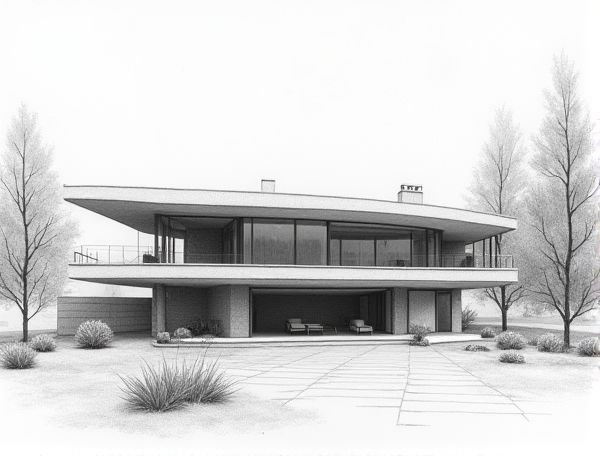
Photo illustration: High-tech home design with kinetic façade elements
High-tech home design incorporates kinetic facade elements that dynamically respond to environmental changes, enhancing energy efficiency and aesthetic appeal while providing personalized comfort. Explore the article to discover how these innovative features can transform your home's functionality and style.
Introduction to High-Tech Home Design
High-tech home design integrates cutting-edge technology with modern aesthetics to create intelligent living spaces that enhance comfort and efficiency. Smart systems control lighting, climate, and security, while sleek materials and innovative layouts optimize space and functionality. Your home transforms into a futuristic environment tailored to your lifestyle needs and technological preferences.
What Are Kinetic Façade Elements?
Kinetic facade elements are dynamic architectural components designed to adapt and respond to environmental conditions such as sunlight, wind, and temperature, enhancing energy efficiency and aesthetic appeal. These elements include movable panels, louvers, and shading devices that can change position automatically or manually to control natural light and ventilation. Incorporating kinetic facades into your home design optimizes comfort while reducing energy costs through intelligent, responsive exterior surfaces.
Benefits of Kinetic Façade Systems in Residences
Kinetic facade systems in residences enhance energy efficiency by adapting to environmental conditions, reducing heating and cooling costs through dynamic shading and ventilation. These systems also improve aesthetic appeal and occupant comfort by allowing responsive natural light control and increased airflow.
Smart Materials for Dynamic Building Envelopes
Smart materials for dynamic building envelopes revolutionize home designing by adapting to environmental changes, enhancing energy efficiency, and improving indoor comfort. Integrating phase-change materials, electrochromic glass, and thermochromic coatings in Your home allows precise control over temperature, light, and ventilation, reducing energy costs and boosting sustainability.
Energy Efficiency and Environmental Impact
Incorporating energy-efficient appliances and high-performance insulation materials significantly reduces household energy consumption and carbon footprint. Utilizing renewable energy sources like solar panels and integrating smart home systems optimize energy use while minimizing environmental impact. Selecting sustainable building materials and implementing passive design strategies further enhance overall energy efficiency in home design.
Integration of Automation and IoT in Façade Design
Integrating automation and IoT in facade design enhances energy efficiency by allowing real-time monitoring and adaptive control of lighting, shading, and ventilation systems. Smart sensors and connected devices optimize your home's thermal performance and security, reducing energy costs and improving comfort. This seamless integration creates an intelligent facade that responds dynamically to environmental changes and user preferences.
Case Studies: Innovative Homes with Kinetic Facades
Kinetic facades in innovative home designs offer dynamic adaptability to environmental changes, enhancing energy efficiency and aesthetic appeal. Case studies reveal how these movable exterior elements regulate sunlight, airflow, and temperature, contributing to sustainable living spaces tailored to your specific needs. Integrating kinetic facades transforms traditional homes into smart, responsive environments that optimize comfort and reduce energy consumption.
Design Challenges and Solutions
Design challenges in home designing often include spatial limitations, budget constraints, and balancing aesthetics with functionality. Innovative solutions like multifunctional furniture, open floor plans, and cost-effective materials optimize small spaces while maintaining style. Emphasizing sustainable design and smart technology integration enhances efficiency and reduces long-term expenses.
Future Trends in Adaptive Architectural Exteriors
Future trends in adaptive architectural exteriors emphasize responsive materials that adjust to environmental changes, such as smart glass and dynamic facades optimizing energy efficiency. Integration of sensors and AI-driven systems enables buildings to modify insulation, lighting, and ventilation in real-time, enhancing sustainability and occupant comfort.
Conclusion: Transforming Home Aesthetics and Functionality
Enhancing home aesthetics and functionality requires a strategic blend of innovative design elements and practical spatial planning. Integrating smart technology with sustainable materials elevates both visual appeal and energy efficiency, creating a harmonious living environment. Tailored interior solutions embody personalized style while maximizing comfort and usability, ultimately transforming any space into a cohesive and inspiring home.
 homedesy.com
homedesy.com